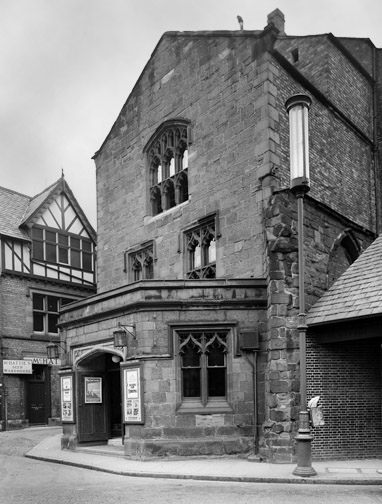The Music Hall
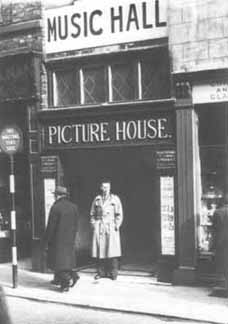 The Superdrug store on Northgate and St Werburgh Streets was once home to the Music Hall Cinema. The Superdrug store on Northgate and St Werburgh Streets was once home to the Music Hall Cinema.
Abbot Simon of the Abbey of St. Werburgh constructed the original building in 1280 as a Chapel dedicated to St Nicholas. With
the
rebuilding
of
the
Abbey's nave
in
the
14th
century,
the
townspeople, who were long accustomed to using
using the the
south
aisle of the Abbey as
their
parish
church- services
being
held
at
an
altar
dedicated
to
St.Oswald-
were
required
by
the
monks
to
move across the road to
the
former
guild
chapel.
Right: The old Music Hall Cinema as it appeared during the 1940s. Projectionist Fred Morgan is pictured standing outside.
Their
new
accomodation
seems
to
have
been
unpopular
with
the
parishioners
as
they
later
returned
to
worship
in
the
south
transept
of
the
Abbey, which was actually walled off from the rest of the great building and remained so until the late 19th century.
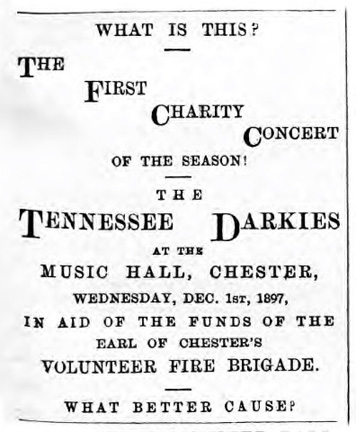
After remaining empty for a time, the old chapel was later used as a wool hall. It had also served as the Common Hall between 1545 and 1698, when the new Exchange was built in the Market Square.
From 1773 it was called The New Theatre, until it was renamed The Theatre Royal in 1777,
where
appeared
such
superstars
of
their
day
as Sarah
Siddons in
1786
and Edmund
Kean in
1815.
Left: a charity concert advertisment from the Chester Courant, December 1897
Both an Act of Parliament and the personal assent of the Monarch were necessary at this time in order to obtain a licence to open a public theatre and copies of that pertaining to Chester still exist, dating from the early part of the reign of George III, 1761.
Licencing was deemed necessary because 18th century theatres were seen by the authorities as hives of propoganda and potential unrest and also as "harbours of drunks, vagabonds, ladies of the night and the worst elements of society".
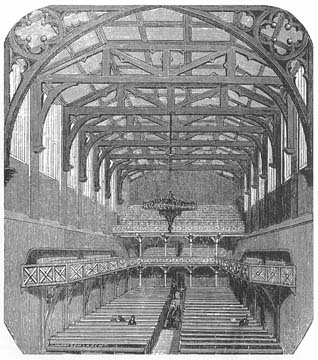 Audiences didn't sit quietly to enjoy a nice play as they do today, but would argue and fight among themselves and throw objects and abuse at the performers if their efforts failed to please. Of the Act relating to Chester, it is interesting to note that it was allied to an Act of Queen Anne for "reducing the laws relating to Rogues, Vagabonds, Sturdy Beggars and Vagrants". Audiences didn't sit quietly to enjoy a nice play as they do today, but would argue and fight among themselves and throw objects and abuse at the performers if their efforts failed to please. Of the Act relating to Chester, it is interesting to note that it was allied to an Act of Queen Anne for "reducing the laws relating to Rogues, Vagabonds, Sturdy Beggars and Vagrants".
The theatre long after remained a source of official suspicion
and plays were required to be licenced by the Lord Chancellor right up to the 1960s.
In 1855 the building became the home of The Chester Music Hall, after being re-designed by architect James Harrison (who, amid much else, was also responsible for the rebuilding of Holy
Trinity
Church in Watergate Street and restoring St. Olave's Church in Lower Bridge Street).
Right: The newly-restored Chester Music Hall as it appeared in 1855
Charles Dickens gave a talk here in 1867 and later described
it
thus: "At Chester we read in a snowstorm and a fall of ice. I think it was the worst weather I ever saw. Nevertheless the people were enthusiastic. The
hall
is
like
a
Methodist
Chapel
in
low
spirits,
and
with
a
cold
in
its
head".
Many other famous names gave lectures including: the explorer Amundson, and Winston Churchill, who spoke on the Boer War in 1901.
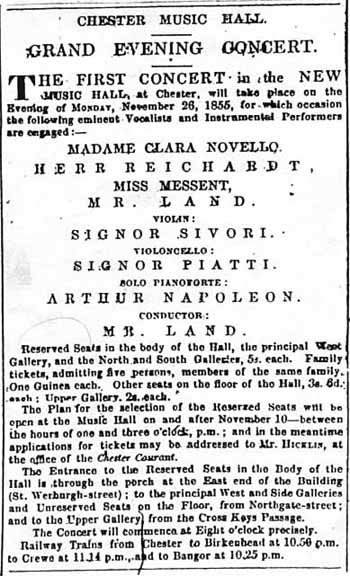 Films were shown occasionally from the early part of the 20th Century. The London Animated Picture Company ran films here in 1908. Films were shown occasionally from the early part of the 20th Century. The London Animated Picture Company ran films here in 1908.
Films were screened on a regular basis from 1915 when it was known as Music Hall Pictures.
Chester Music Hall (1921) Ltd re-constructed the hall and ran the cinema from 1921.The screen was moved from the St Werberg Street end to the Northgate end.
The first film to flicker through the projectors was Charles Chaplin's The Kid, opening in November 1921. Chester's first 'talkie', The Singing Fool starring Al Jolson, was seen at the Music Hall from September 23 1929 (see poster above). The sound was on disc. This was short lived and soon sound would be carried on film. (Jolson's earlier film, The Jazz Singer, was the world's first ‘talkie’ film, made in 1927)
For many years the cinema was managed by William Mulvey. The final manager was Alfred Newton. The box office telephone number was Chester 20380.
General Theatres, a part of Gaumont British, ran the cinema from 1928-1948, in which year Gaumont and Rank merged, forming Circuits Management Association.
Left: advertisment for the opening of the Music Hall: November 26th 1855
At the time of the Music Hall's closure in April 1961, it was still run by CMA. The final offering was Never on Sunday. This tied in nicely because the building never had opened on a Sunday.
Since closure the building has been many things, including a branch of Lipton's (see photograph below)- Chester's first supermarket within the Walls- Foster's gents outfitters in 1978 and The Reject Shop. It is currently home to a branch of Superdrug.
Recently a couple of friends and I (writes David Ellis) visited the former projection room, which is now used for storage- Gordon Potter, ex chief projectionist of the Odeon and Vincent Dunning, who had worked there in the 1940s.
We asked manager Mark, who was extremely helpful, if we could take a peep. We were particularly interested in the projection room, as all three of us had worked as projectionists- myself at the 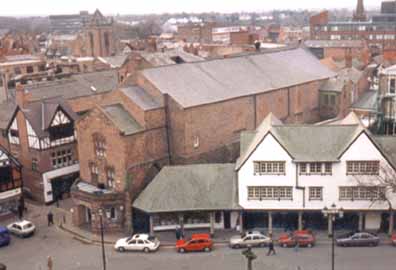
Classic in the sixties. When we stepped into the old projection area, Vincent said it was like stepping back in time. To our surprise the fire shutters were still in place. These, when lifted reveal the portholes that allow the projectors to let light through and the projectionist to view.
Right: the 13th century Chapel of St. Nicolas- much altered and enlarged over the years to accomodate a theatre, cinema and a variety of shops- photographed from the roof of Chester Cathedral by Steve Howe in 1997.
All technical equipment had long gone but you could imagine what it had been like. And still there were two ‘No Smoking’ signs, painted on the box and rewind room walls- reminding us that films were once highly flammable.
Vincent talked about his days as an operator telling us that the floor was always painted red- traces could still be seen. He showed us what had been the entrance to the balcony area and told us that during the summer the heat was almost unbearable in the box due to the confined apace and heat generated from the carbon arcs.
“The pay was poor and the hours were unsociable, but I loved every minute of it” said Vin.
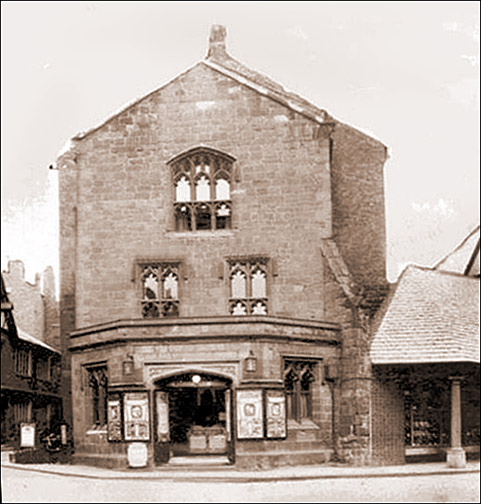
The Music Hall Cinema in 1945

Now go on to learn a little of Chester’s first ‘super cinema’, the Gaumont Palace, in Brook Street...
|




 Audiences didn't sit quietly to enjoy a nice play as they do today, but would argue and fight among themselves and throw objects and abuse at the performers if their efforts failed to please. Of the Act relating to Chester, it is interesting to note that it was allied to an Act of Queen Anne for "reducing the laws relating to Rogues, Vagabonds, Sturdy Beggars and Vagrants".
Audiences didn't sit quietly to enjoy a nice play as they do today, but would argue and fight among themselves and throw objects and abuse at the performers if their efforts failed to please. Of the Act relating to Chester, it is interesting to note that it was allied to an Act of Queen Anne for "reducing the laws relating to Rogues, Vagabonds, Sturdy Beggars and Vagrants". Films were shown occasionally from the early part of the 20th Century. The London Animated Picture Company ran films here in 1908.
Films were shown occasionally from the early part of the 20th Century. The London Animated Picture Company ran films here in 1908.

